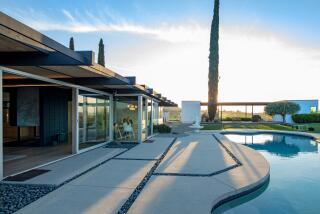A rare Case Study jewel sells amid Bel-Air’s mansions
In a rare transaction, a Case Study House in Bel-Air has sold for nearly $3 million after its owner, who lived in the two-bedroom property since the late 1950s, recently died.
Rarer still is Case Study House No. 16’s condition: pristine. For 52 years, New York transplant Muriel Norton didn’t mar or bend any of the crisply set rectilinear lines in the steel, concrete and brick structure artfully clad in glass (Norton bought the property in 1967, most likely after having rented it the previous decade).
The 1953 home remains a light-infused modernist ornament — modest at 1,664 square feet — amid Bel-Air’s mash of mansions, stone walls and pillared gates.
Rarest of all, however, is the architect who designed the modular property for his former employer, Henry Salzman. The onetime Johnnie Burke was a Texas transplant who SoCal-reinvented himself as Craig Ellwood, snatching his new moniker from L.A.’s Lords & Elwood liquor store.
Dubbed the “Cary Grant of architecture” by a business associate, the bon vivant (“He could charm the birds off the trees,” said another associate) reportedly could not draft, draw or grasp structural engineering (he tried to catch up by taking UCLA engineering extension night classes).
Ellwood’s bent for self-promotion and his visionary style — the “less is more” essential clarity of Ludwig Mies van der Rohe, fused with a jaunty L.A. aesthetic — made him dashingly famous.
Tooling around Hollywood in his red Ferrari with its VROOM license plate, the nattily dressed Ellwood was lauded by architects of the day; German modernist Konrad Wachsmann compared him to Picasso and Stravinsky.
His greatest sin, however, was failing to credit the adept architects and student draftsmen who largely realized the Ellwood brand. Those details are found in “California Modern,” a fascinating 2002 Ellwood biography by Neil Jackson.
Ellwood’s celebritized career included two other homes (now ruinously altered) for Arts & Architecture’s experimental Case Study House Program of the mid 1940s-60s, and was augmented by a second marriage to actress Gloria Henry. Ellwood married twice more, folded his firm in 1977 and retired to Italy to paint; he died in 1992.
If all that sounds like a madcap midcentury Netflix series outfitted with Mrs. Maisel-worthy costumes — you’re right, and you’re also out of luck. Television writer Kit Boss is already pitching a pilot script drawing from Ellwood’s life as detailed in Jackson’s book. Boss is a former journalist and sponsored No. 16’s Historic-Cultural Monument application, approved by the city in 2017.
Until Ellwood’s made-for-TV life hits your screen, a tour of his Bel-Air number will suffice; Compass agent Dalton Gomez recently gave an early morning showing. Along with Gomez, Aaron Kirman and Weston Littlefield of the Aaron Kirman Group at Compass hold the listing; the sale is expected to close escrow by year’s end.
After a serpentine drive up Bel-Air Road, a wall of translucent panels that shield bedrooms appears at a crest’s bend; as dusk falls, the home appears as a luminous hilltop lantern. To the right, a low brick wall delineates the entry from the carport. More frosted panels are placed further back.
The foyer and various other walls are lined with grooved vertical Douglas fir that matches exterior siding. To the right is the boxy kitchen with white-enameled steel cabinets, its far counter overlooking the dining room. Joined, the rooms are a tidy package, save for a window’s hulking view of an adjacent three-story, six-bedroom manse listed for nearly $7 million (which includes renderings for a proposed 12,000-square-foot replacement).
Given such surroundings, the Ellwood home “is a bit of a white elephant for that pocket,” said Kirman, whose last Case Study House sale, finessed with Gomez, was in February: No. 21 for $3.26 million.
Straight ahead and to the right, the foyer opens to the vast living room, its glass walls fitted with Steelbilt sliding doors that, when opened, emit an ear-splitting screech. “They need some work,” said Gomez, opening a door framing a west-facing vista of far hills. The south elevation boasts a similar view; there, a steel pergola painted burgundy (a color used throughout) extends from the home’s fascia.
The space is made deceptively larger by wall dividers that appear to float. The panels halt a foot or more from the ceiling, allowing for open space; their black-painted bases further the illusion that there’s no floor or ceiling connection. The home’s wide overhangs also augment the space.
The living room’s Palos Verdes stone-clad fireplace continues through the glass, creating a second outdoor patio hearth anchored by three ancient eucalyptuses. A squat brick wall is fixed with climbing bars “that also act as a minimalist sculpture,” states the National Register of Historic Places registration for the home.
Besides No. 16, Ellwood created other standouts, including Malibu’s 1957 Hunt House, designed with Jerrold Lomax, as well as Pasadena’s Art Center College of Design.
Completed in 1976, the Art Center’s “bridge building” traverses an Arroyo Seco canyon. Though described as Ellwood’s swan song, his associate James Tyler, a former adjunct professor at USC School of Architecture, is now credited as the building’s principal designer.






